CHEVROLET CORVETTE 1994 4.G Owners Manual
Manufacturer: CHEVROLET, Model Year: 1994, Model line: CORVETTE, Model: CHEVROLET CORVETTE 1994 4.GPages: 274, PDF Size: 15.61 MB
Page 121 of 274

Downloaded from www.Manualslib.com manuals search engine Notes
I
. . .I20
Page 122 of 274
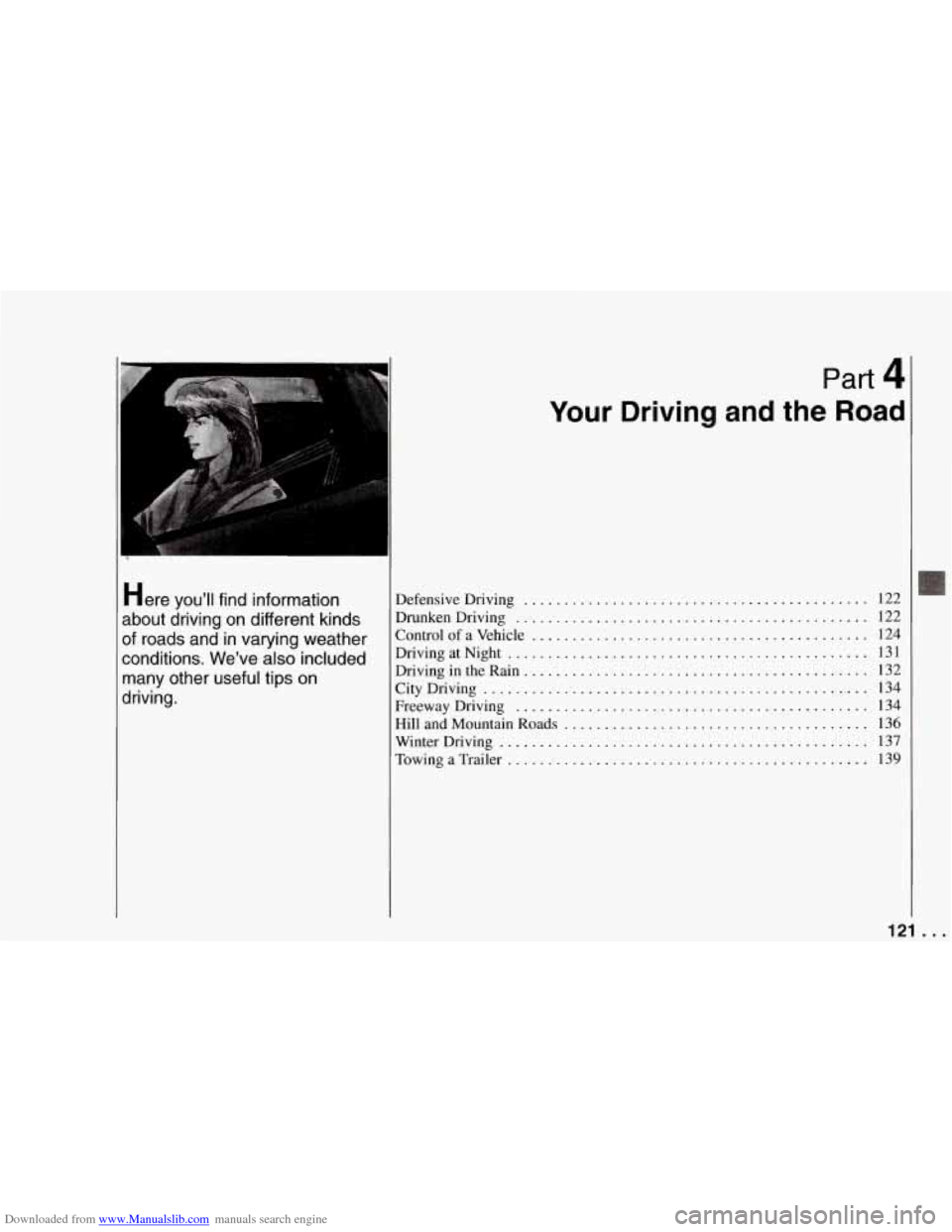
Downloaded from www.Manualslib.com manuals search engine Here YOU’II find information
about driving on different kinds
of roads and in varying weather
conditions
. We’ve also included
many other useful tips on
driving
.
Part 4
Your Driving and the Road
Defensive Driving ...........................................
DrunkenDriving ............................................
Clontrol of a Vehicle ...........................................
]rivingatNight .............................................
]riving in the Rain ...................... ...........
Jity Driving ........................... ..............
?reeway Driving .......................... ...........
Winter Driving ............................................
rowing a Trailer .......................................
gill and Mountain Roads ................. ..............
122
122
24
31
32
34
34
36
37
39
121 ...
Page 123 of 274
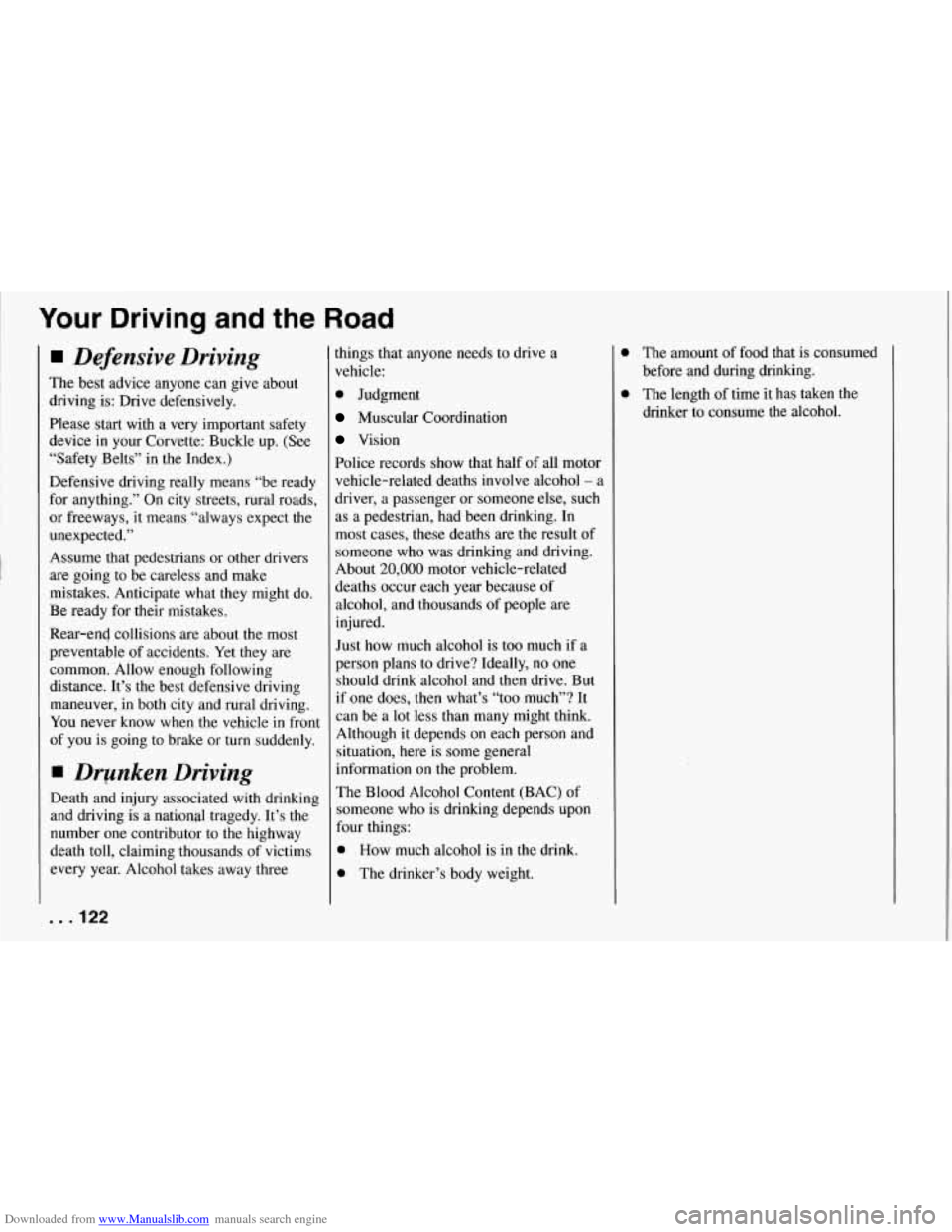
Downloaded from www.Manualslib.com manuals search engine I Your Driving and the Road
Defensive Driving
The best advice anyone can give about
driving is: Drive defensively.
Please start with a very important safety
device in your Corvette: Buckle up. (See
“Safety Belts” in the Index.)
Defensive driving really means “be ready
for anything.” On city streets, rural roads,
or freeways, it means “always expect the
unexpected.’’
Assume that pedestrians or other drivers
are going to be careless and make
mistakes. Anticipate what they might do.
Be ready for their mistakes.
Rear-en4 collisions are about
the most
preventable of accidents. Yet they are
common. Allow enough following
distance. It’s the best defensive driving
maneuver, in both city and rural driving.
You never know when the vehicle
in front
of you is going to brake or turn suddenly.
Drpnken Driving
Death and injury associated with drinking
and driving is a natioqal tragedy. It’s the
number one contributor to the highway
death toll, claiming thousands of victims
every year. Alcohol takes away three
. .I22
things that anyone needs to drive a
vehicle:
0 Judgment
Muscular Coordination
Vision
Police records show that half of all motor
vehicle-related deaths involve alcohol
- a
driver, a passenger or someone else, such
as a pedestrian, had been drinking. In
most cases, these deaths are the result of
someone who was drinking and driving.
About
20,000 motor vehicle-related
deaths occur each year because of
alcohol, and thousands of people are
injured.
Just how much alcohol is too much if a
person plans to drive? Ideally,
no one
should drink alcohol and then drive. But
if one does, then what’s “too much”? It
can be a lot less than many might think.
Although it depends
on each person and
situation, here is some general
information on the problem.
The Blood Alcohol Content (BAC) of
someone who is drinking depends upon
four things:
0 How much alcohol is in the drink.
0 The drinker’s body weight.
0
0
The amount of food that is consumed
before and during drinking.
The length of time
it has taken the
drinker to consume the alcohol.
Page 124 of 274
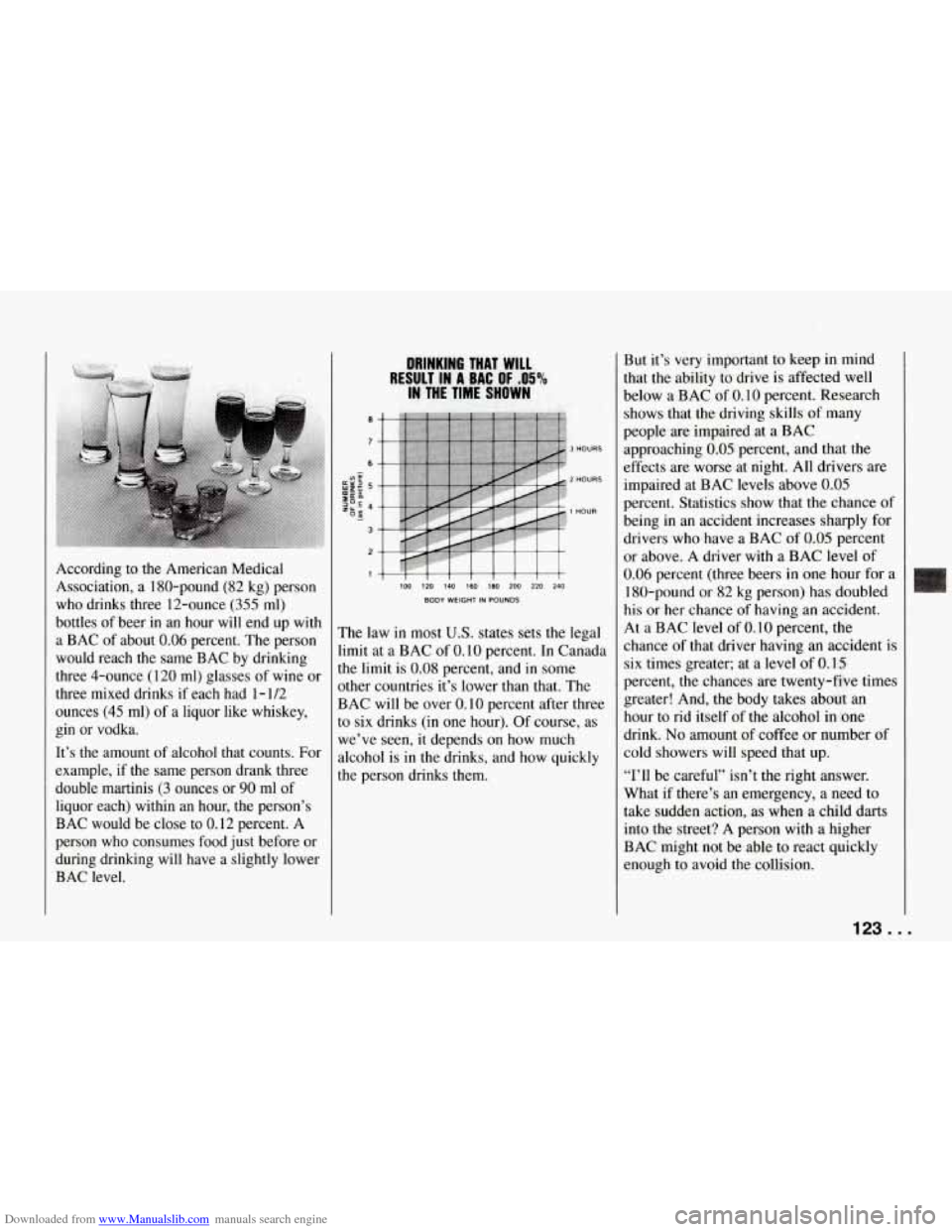
Downloaded from www.Manualslib.com manuals search engine According to the American Medical
Association, a 180-pound (82 kg) person
who drinks three 12-ounce (355 ml)
bottles
of beer in an hour will end up with
a BAC of about
0.06 percent. The person
would reach the same BAC by drinking
three 4-ounce (1 20
ml) glasses of wine or
three mixed drinks if each had 1
- 1/2
ounces (45 ml) of a liquor like whiskey,
gin or vodka.
It’s the amount of alcohol that counts. For
example, if
the same person drank three
double martinis (3 ounces or
90 ml of
liquor each) within
an hour, the person’s
BAC would be close to 0.12 percent. A
person who consumes food just before or
during drinking will have
a slightly lower
BAC level.
DRIN’KING THAT WILL
IN THE TIME SHOWN
RESULT IN A BAC OF. .OS%
3 HOURS
2 HOURS
1 HOUR
111l1111 IW 120 140 160 1.30 m 220 240
BODY WEIGHT IN POUNDS
The law in most U.S. states sets the legal
limit at a BAC of 0.10 percent.
In Canada
the limit is
0.08 percent, and in some
other countries it’s lower than that. The
BAC will be over
0.10 percent after three
to six drinks (in one hour). Of course, as
we’ve seen, it depends on how much
alcohol is in the drinks, and how quickly
the person drinks them.
.,. c. .-’ .t
But it’s very important to keep in mind
that the ability to drive is affected well
below a BAC of 0.10 percent. Research
shows that the driving skills
of many
people ai-e impaired at a BAC
approaching
0.05 percent, and that the
effects are worse at night. All drivers are
impaired at BAC levels above
0.05
percent. Statistics show that the chance of
being in an accident increases sharply for
drivers who have a BAC of
0.05 percent
or above. A driver with a BAC level of
0.06 percent (three beers in one hour for a
180-pound or 82 kg person) has doubled
his or her chance of having an accident.
At a BAC level of 0.10 percent, the
chance of that driver having an accident is
six times greater; at a level of
0.15.
percent, the chances are twenty-five times
greater! And, the body takes about an
hour to rid itself
of the alcohol in :one
drink.
No amount of coffee or number of
cold showers will speed that
up.
“I’ll be careful” isn’t the right answer.
What if there’s
an emergency, a need to
take sudden action, as when a child darts
into the street? A person with a higher
BAC might not be able to react quickly
enough to avoid the collision.
123 ...
Page 125 of 274
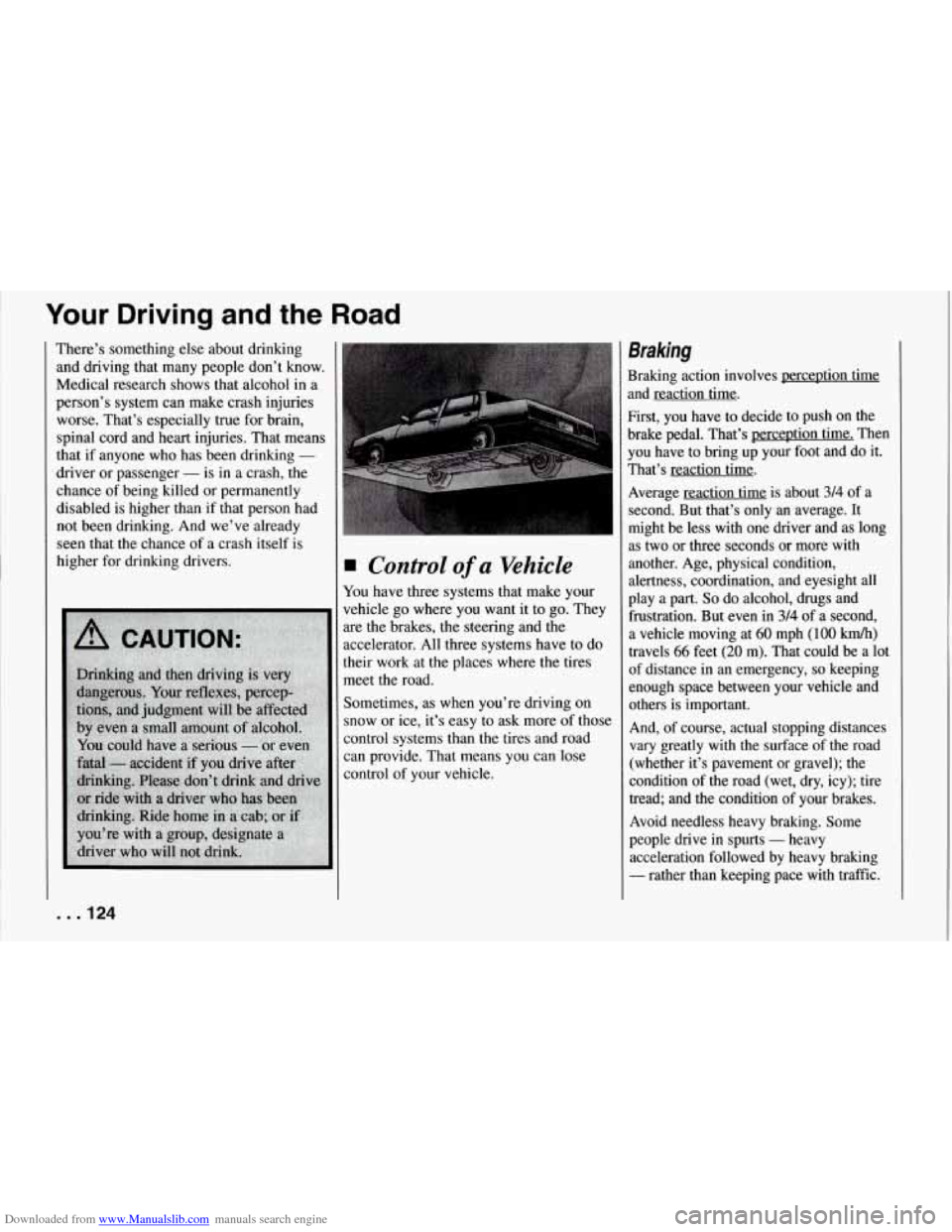
Downloaded from www.Manualslib.com manuals search engine Your Driving and the Road
There’s something else about drinking
and driving that many people don’t know.
Medical research shows that alcohol in a
person’s system can make crash injuries
worse. That’s especially true for brain,
spinal cord and heart injuries. That means
that if anyone who has been drinking
-
driver or passenger - is in a crash, the
chance
of being killed or permanently
disabled is higher than if that person had
not been drinking. And we’ve already
seen that the chance of a crash itself is
higher for drinking drivers.
. . .124
Control of a Vehicle
You have three systems that make your
vehicle
go where you want it to go. They
are the brakes, the steering and the
accelerator. All three systems have to do
their work at the places where the tires
meet the road.
Sometimes, as when you’re driving on
snow or
ice, it’s easy to ask more of those
control systems than the tires and road
can provide. That means you can lose
control of your vehicle.
Braking
Braking action involves perception time
and reaction time.
First, you have to decide to push on the
brake pedal. That’s perception time. Then
you have to bring up your foot and do it.
That’s reaction time.
Average reaction time is about
314 of a
second. But that’s only
an average. It
might be less with one driver and as long
as two or three seconds or more with another. Age, physical condition,
alertness, coordination, and eyesight all
play a part.
So do alcohol, drugs and
frustration. But even in
314 of a second,
a vehicle moving at
60 mph (100 km/h)
travels 66 feet (20 m). That could be a lot
of distance in an emergency, so keeping
enough space between your vehicle and others is important.
And, of course, actual stopping distances
vary greatly with the surface of the road
(whether it’s pavement or gravel); the
condition of the road (wet, dry, icy); tire
tread; and the condition of your brakes.
Avoid needless heavy braking. Some
people drive in spurts
- heavy
acceleration followed by heavy braking
- rather than keeping pace with traffic.
Page 126 of 274
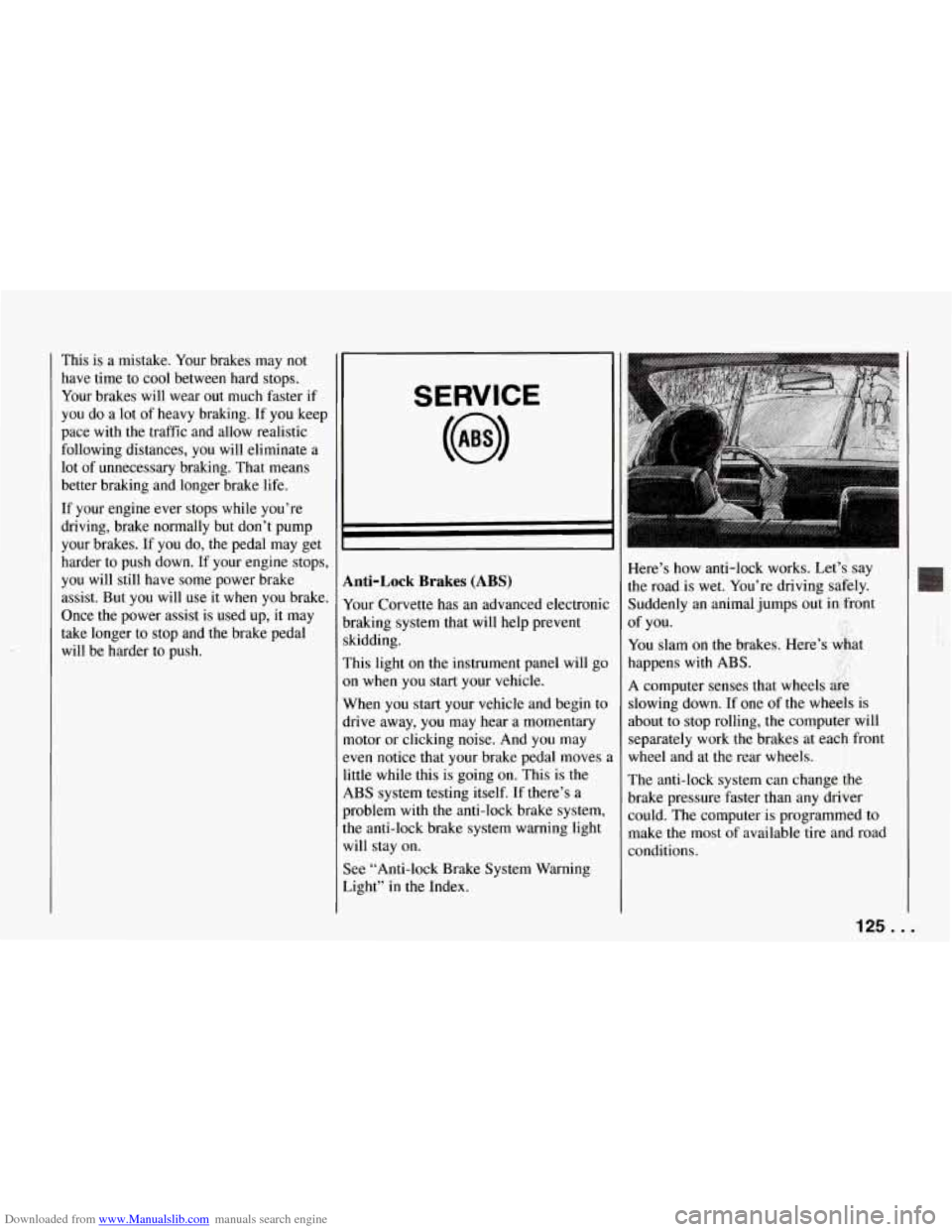
Downloaded from www.Manualslib.com manuals search engine This is a mistake. Your brakes may not
have time to cool between hard stops.
Your brakes will wear out much faster if
you do a lot
of heavy braking. If you keep
pace with the traffic and allow realistic
following distances, you will eliminate a
lot of unnecessary braking. That means
better braking and longer brake life.
If your engine ever stops while you’re
driving, brake normally but don’t pump
your brakes. If you do, the pedal may get
harder to push down. If your engine stops,
you will still have some power brake
assist. But you will use it
when you brake.
Once the power assist is used up, it may
take longer to stop and the brake pedal
will be harder to push.
SERVICE
I
Anti-Lock Brakes (ABS)
Your Corvette has an advanced electronic
braking system that will help prevent
skidding.
This light on the instrument panel will go
on when you start your vehicle.
When you start your vehicle and begin to
drive away, you may hear a momentary
motor or clicking noise. And you may
even notice that your brake pedal moves
,
little while this is going on. This is the
ABS system testing itself. If there’s a
problem with the anti-lock brake system,
the anti-lock brake system warning light
will stay on.
See “Anti-lock Brake System Warning
Light” in the Index. Here’s how anti-lock works. Let’s, say
the road
is wet. You’re driving safely.
Suddenly an animal jumps out in front
You slam on the brakes. Here’s &at
happens with
ABS. ..
A computer senses that wheels &g,
slowing down. If one of the wheels is
about to stop rolling, the computer will
separately work the brakes at each front
wheel and at the rear wheels.
The anti-lock system can change
the
brake pressure faster than any driver
could. The computer is programmed to
make the most of available tire and road
conditions. of
you.
125..,
Page 127 of 274
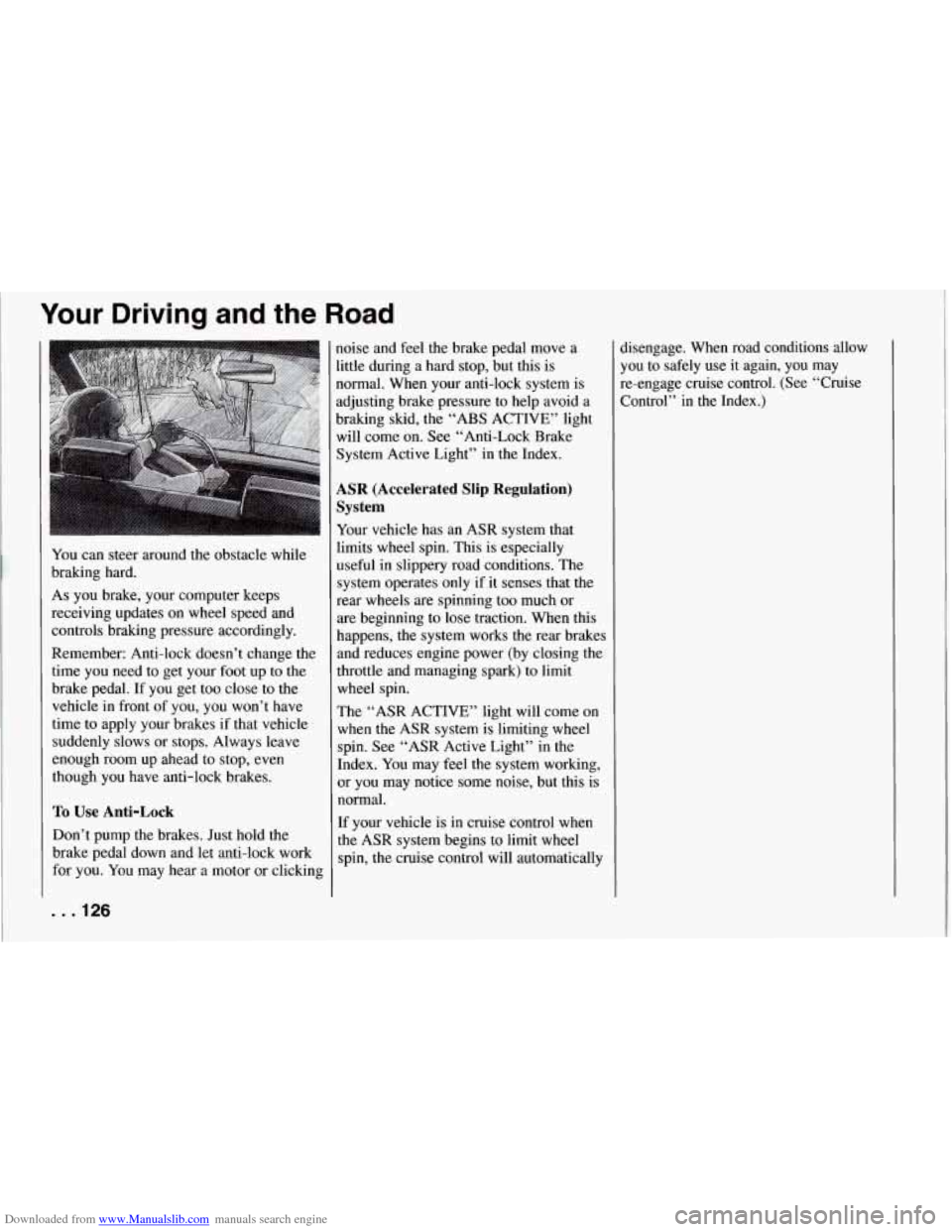
Downloaded from www.Manualslib.com manuals search engine Your Driving and the Road
You can steer around the obstacle while
braking hard.
As you brake, your computer keeps
receiving updates on wheel speed and
controls braking pressure accordingly.
Remember: Anti-lock doesn’t change the
time you need to get your foot up to the
brake pedal.
If you get too close to the
vehicle
in front of you, you won’t have
time to apply your brakes if that vehicle
suddenly slows or stops. Always leave
enough room up ahead to stop, even
though you have anti-lock brakes.
To Use Anti-Lock
Don’t pump the brakes. Just hold the
brake pedal down and let anti-lock work
for you. You may hear a motor or clicking
. . .I26
noise and feel the brake pedal move a
little during a hard stop, but this is
normal. When your anti-lock system is
adjusting brake pressure to help avoid a
braking skid, the “ABS ACTIVE” light
will come on. See “Anti-Lock Brake
System Active Light” in the Index.
ASR (Accelerated Slip Regulation)
System
Your vehicle has an ASR system that
limits wheel spin. This is especially
useful in slippery road conditions. The
system operates only if it senses that the
rear wheels are spinning too much or
are beginning to lose traction. When this
happens, the system works
the rear brakes
and reduces engine power (by closing the
throttle and managing spark) to limit
wheel spin.
The “ASR ACTIVE” light will come on
when the ASR system is limiting wheel
spin. See “ASR Active Light”
in the
Index. You may feel the system working,
or you may notice some noise, but this is
normal.
If your vehicle is in cruise control when
the ASR system begins to limit wheel
spin, the cruise control will automatically disengage. When road conditions allow
you to safely use it again, you may
re-engage cruise control. (See “Cruise
Control” in the Index.)
Page 128 of 274
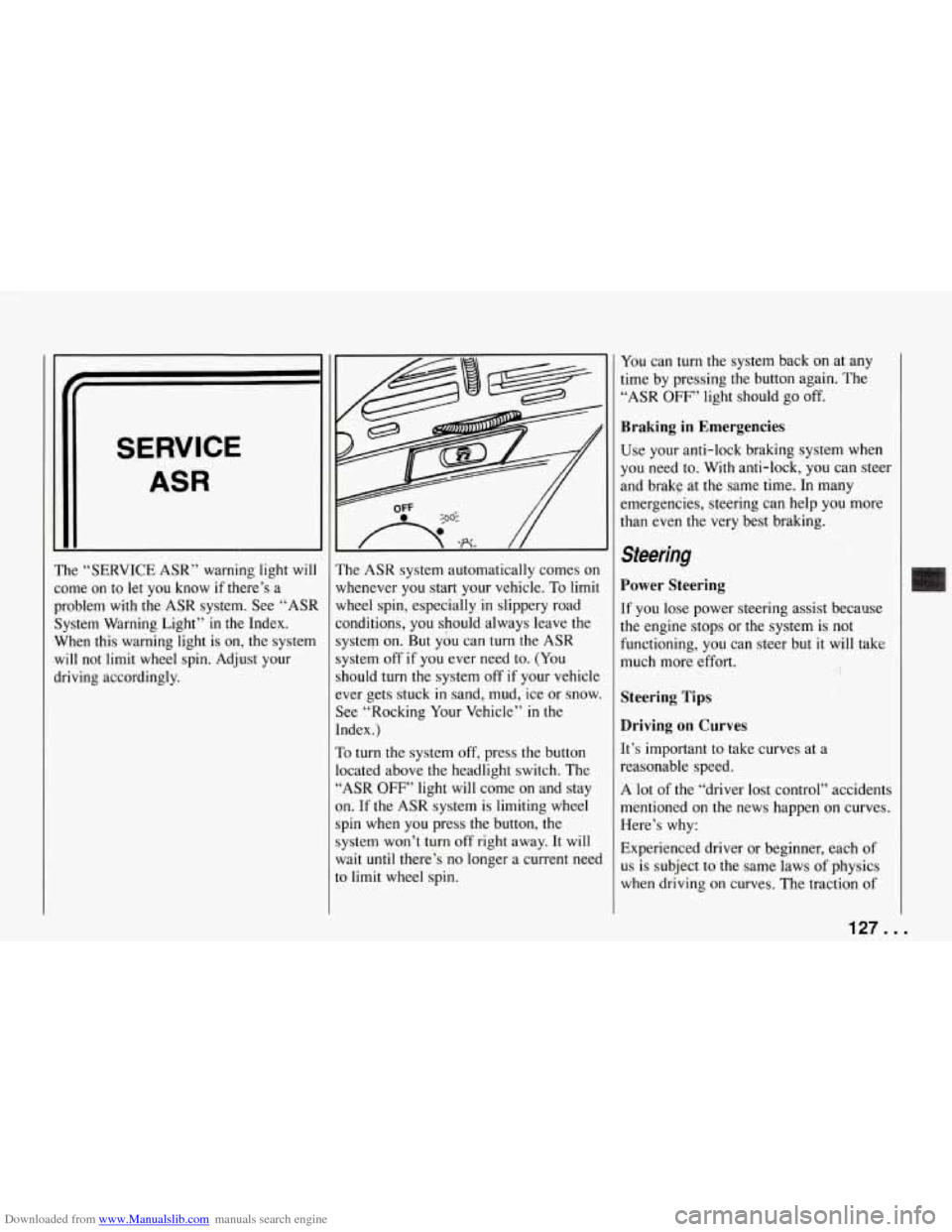
Downloaded from www.Manualslib.com manuals search engine The
comc
prob
Whe
will
drivi Systc
SERVICE
ASR
“SERVICE ASR“ warning light will
2 on
to let you know if there’s a
lem with the ASR system. See “ASR
:m Warning Light” in the Index.
n this warning light is on, the system
not limit wheel spin. Adjust your
ng accordingly. The
ASR system automatically comes on
whenever you start your vehicle. To limit
wheel spin, especially in slippery road
conditions, you should always leave the
system on. But you can turn the ASR
system off
if you ever need to. (You
should turn the system off if your vehicle
ever gets stuck
in sand, mud, ice or snow.
See “Rocking Your Vehicle” in the
Index.)
To
turn the system off, press the button
located above the headlight switch. The
“ASR
OFF’ light will come on and stay
on. If the ASR system is limiting wheel
spin when you press the button, the
system won’t turn off right away. It will
wait until there’s no longer a current
need
to limit wheel spin.
You can turn the system back on at any
time by pressing the button again. The
“ASR
OFF’ light should go off.
Braking in Emergencies
Use your anti-lock braking system when
you need to. With anti-lock, you can steer
and brakG at the same time. In many
emergencies, steering can help you more
than even the very best braking.
Steering
; .1
,.
Power Steering
If you lose power steering assist because
the engine stops or the system is not
functioning, you can steer but it will take
much more effort.
Steering Tips
Driving on Curves
It’s important to take curves at a
reasonable speed.
A lot
of the “driver lost control” accidents
mentioned
on the news happen on curves.
Here’s why:
Experienced driver or beginner, each
of
us is subject to the same laws of physics
when driving on curves. The traction of
127 ...
Page 129 of 274
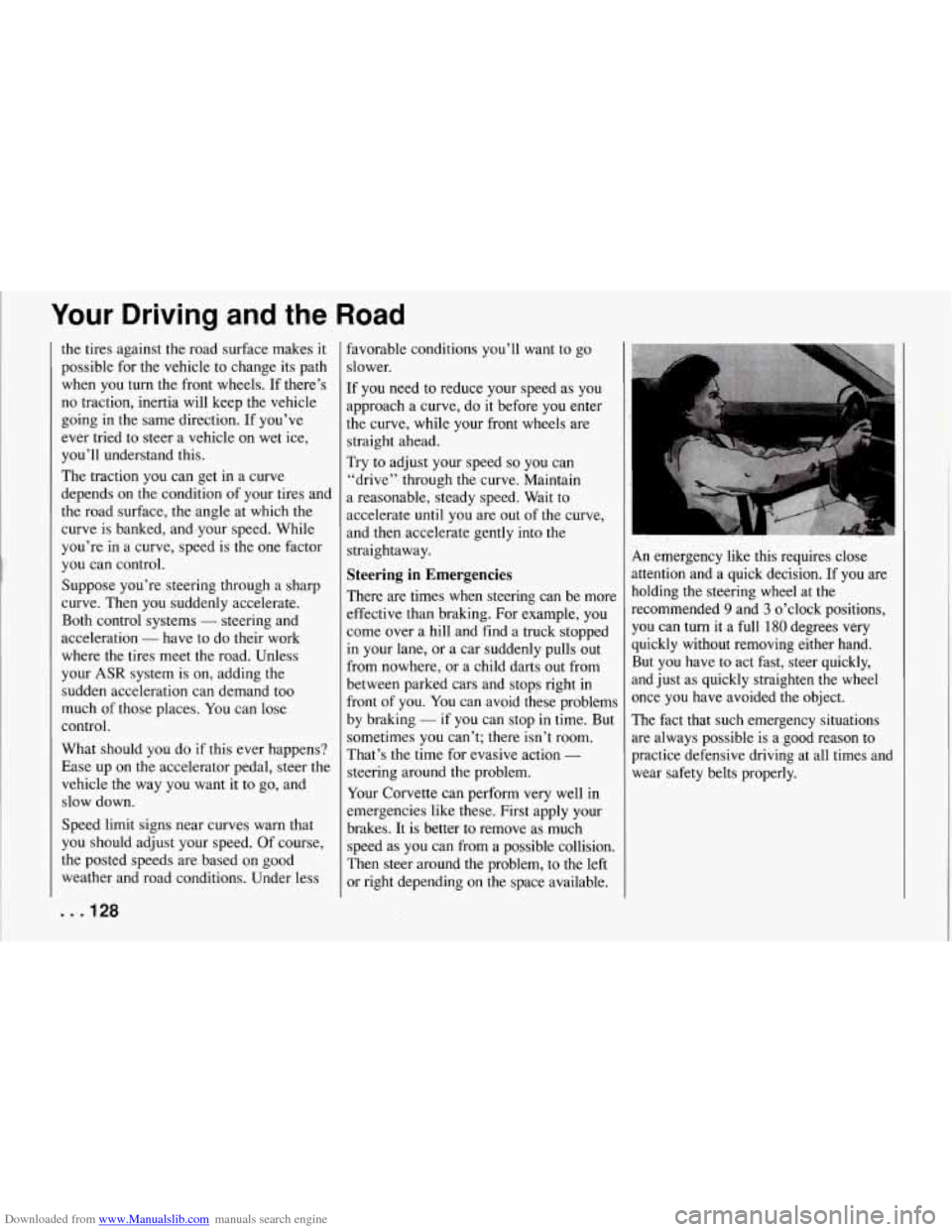
Downloaded from www.Manualslib.com manuals search engine Your Driving and the Road
the tires against the road surface makes it
possible for the vehicle to change its path
when you
turn the front wheels. If there’s
no traction, inertia will keep the vehicle
going in the same direction. If you’ve
ever tried to steer a vehicle
on wet ice,
you’ll understand this.
The traction you can get in a curve
depends on the condition of your tires and
the road surface, the angle at which
the
curve is banked, and,your speed. While
you’re in a curve, speed is the one factor
you can control.
Suppose you’re steering through a sharp
curve. Then you suddenly accelerate.
Both control systems
- steering and
acceleration
- have to do their work
where the tires meet the road. Unless
your
ASR system is on, adding the
sudden acceleration can demand too
much of those places. You can lose
control.
What should you do if this ever happens?
Ease up on the accelerator pedal, steer the
vehicle the way you want it to go, and
slow down.
Speed limit signs near curves warn that
you should adjust your speed. Of course,
the posted speeds are based on good
weather and road conditions. Under less favorable conditions
you’ll want to go
slower.
If you need to reduce your speed as
you
approach a curve, do it before you enter
the curve, while your front wheels are
straight ahead.
Try to adjust your speed
so you can
“drive”. through the curve. Maintain
a reasonable, steady speed. Wait to
accelerate until you are out of
the curve,
and then accelerate gently into the
straightaway.
Steering in Emergencies
There are times when steering can be more
effective than braking. For example, you
come over a hill and find a truck stopped
in your lane, or a car suddenly pulls out
from nowhere, or a child darts out from
between parked cars and stops right in
front of you. You can avoid these problems
by braking
- if you can stop in time. But
sometimes you can’t; there isn’t room.
That’s the time for evasive action
-
steering around the problem.
Your Corvette can perform very well in
emergencies like these. First apply your
brakes. It is better to remove as much speed as you can from a possible collision.
Then steer around the problem, to the left
or right depending on the space available.
An emergency like this requires close
attention and a quick decision. If you are
holding the steering wheel at the recommended
9 and 3 o’clock positions,
you can turn it a full
180 degrees very
quickly without removing either hand. But you have to act fast, steer quickly,
and just as quickly straighten the wheel
once you have avoided the object.
The fact that such emergency situations
are always possible is
a good reason to
practice defensive driving at all times and
wear safety belts properly.
Page 130 of 274
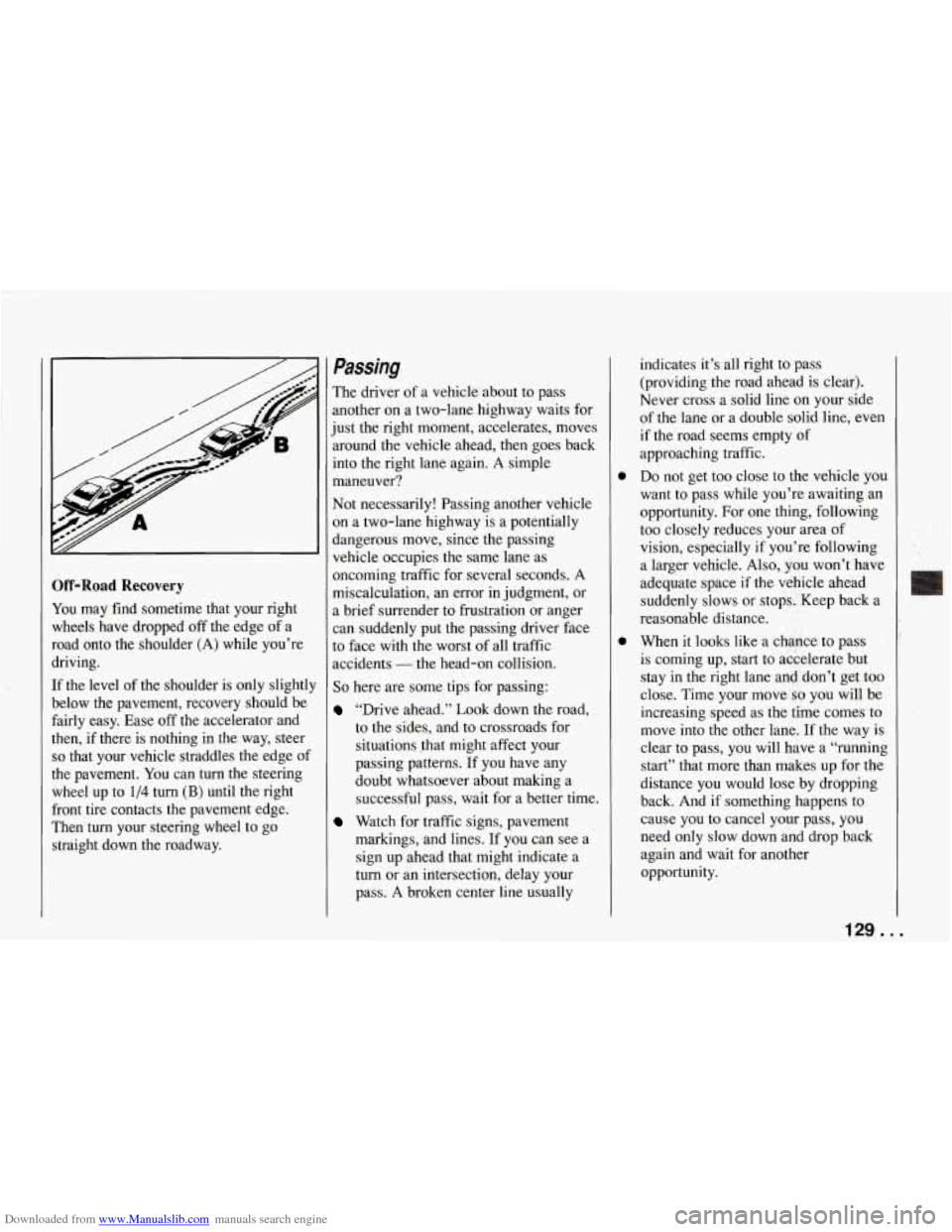
Downloaded from www.Manualslib.com manuals search engine Off-Road Recovery
You may find sometime that your right
wheels have dropped off the edge of a
road onto the shoulder (A) while you’re
driving.
If the level of the shoulder is only slight11
below the pavement, recovery should be
fairly easy. Ease off the accelerator and
then,
if there is nothing in the way, steer
so that your vehicle straddles the edge of
the pavement.
You can turn the steering
wheel up to
1/4 turn (B) until the right
front tire contacts the pavement edge.
Then turn your steering wheel to
go
straight down the roadway.
Passing
fhe driver of a vehicle about to pass
mother on a two-lane highway waits for
ust the right moment, accelerates, moves
tround the vehicle ahead, then goes back
.nto the right lane again.
A simple
naneuver?
Vot necessarily! Passing another vehicle
In a two-lane highway is a potentially
langerous move, since the passing
fehicle occupies the same lane as
Incoming traffic for several seconds. A
niscalculation, an error in judgment, or
brief surrender to frustration or anger
:an suddenly put the passing driver face
:o face with the worst of all traffic
lccidents
- the head-on collision.
So here are some tips for passing:
“Drive ahead.” Look down the road,
to the sides, and
to crossroads for
situations that might affect your
passing patterns. If you have any
doubt whatsoever about making a
successful pass, wait for a better time.
Watch for traffic signs, pavement
markings, and lines. If you can see a
sign up ahead that might indicate a
turn or an intersection, delay your
pass. A broken center line usually indicates
it’s all right to pass
(providing the road ahead
is clear).
Never cross a solid line on your side
of the lane or a double solid line, even
if the road seems empty of
approaching traffic.
Do not get too close to the vehicle you
want to pass while you’re awaiting an
opportunity. For one thing, following
too closely reduces your area of
vision, especially if you’re following
a larger vehicle. Also, you won’t have
adequate space if the vehicle ahead
suddenly slows or stops. Keep back a
reasonable distance.
When it looks like a chance to pass
is coming up, start to accelerate but
stay in the right lane and don’t get too
close. Time your move
so you will be
increasing speed as the time comes to
move into the other lane. If the way is
clear to pass, you will have a “running
start” that more than makes up for the
distance you would lose by dropping
back. And if something happens to
cause you to cancel your pass, you
need only slow down and drop back
again and wait for another
opportunity.